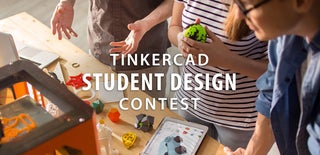Introduction: Rock(et)ing Chair! (Mashup)
Have you ever wanted to launch off the ground like an astronaut from the comfort of your own living room? Or give Grandma the surprise of her life as she sits on the rocking chair and knits a sweater? Presenting, the Rock(et)ing Chair!
I have always been fascinated by rockets and space exploration; however, I am still a little too young to fly to space, so this chair is the next best option. The chair is powered by two thrust-vectoring liquid rocket engines and an external fuel tank. This chair isn't meant for long distance flight, but more so for brief joyrides. All movement is controlled via a touchscreen display attached to the chair. And of course, the chair functions as a pretty amazing rocking chair too!
Maybe one day we'll see this chair in action... but for now, I hope you enjoy my "mashup" creation!
Supplies
All you need is Tinkercad and a computer!
Step 1: Building the Base of the Chair
Let's start by building the base of the chair! I included the dimensions I used (length x width x height), but feel free to use your own.
- Create a box with dimensions 25mm x 25mm x 3mm. Tilt the box backwards by -8° and lift the box 42mm above the workplane.
- Create 2 cylinders with diameters of 4mm and heights of about 40mm (for the front of the chair). Tilt them backwards by -8°, lift them above the workplane, and place them at the front two edges of the box. Use the align tool to ensure they are in line with each other.
- Create 2 cylinders with diameters of 4mm and heights of about 58mm (for the back of the chair). Tilt them backwards by -8°, lift them above the workplane, and place them at the back two edges of the box. Use the align tool to ensure they are in line with each other.
- Create 2 cycloids (which can be found on page 10 of "Shape Generators"), and reduce the height to about 5.5mm. The length I used was about 54mm. Attach each cycloid to the bottoms of the cylinders on each side of the chair.
Step 2: Headrest and Armrests for the Chair
Next up are the headrests and armrests! For these, you can use rectangular boxes once again, tilting them 8° (or whatever angle you choose to use) to match the other components.
Position the armrests over the cylinders, using the align tool to line them up with each other. For the head rest, position it in between the two back cylinders.
Here are the dimensions I used:
Armrests: 20mm x 5mm x 2mm
Headboard: 22mm x 3mm x 13mm
Step 3: The Fun Part! Propulsion System Nozzle
Now we have to get this thing off of the ground! To create the liquid rocket engines, we can use cones. Create a solid cone with a top radius smaller (about half) than the base radius. Then, create a "hole" cone with a top and base radius slightly smaller than that of the solid cone. Align the cones together, and group them together in order to create the nozzle that we want.
Dimensions I used:
Solid cone: Top radius of 6mm, base radius of 10mm, height of about 20mm
Hole cone: Top radius of 5mm, base radius of 9mm, height of about 20mm
Cylinder: Diameter 16mm, height 20mm
Step 4: Rest of Propulsion System
Then, use a cylinder (with a diameter less than the bottom diameter of the cone) and a paraboloid (with a diameter equal to that of the cylinder) to construct the rest of the booster. Place the cylinder on top of the nozzle, again using the align tool to center it on top of the nozzle. Finally, place the paraboloid on top of the cylinder, and group the objects together.
Step 5: Exhaust!
To create an interesting exhaust effect for the nozzle of the rocket engine, we can use "rock mountain" (can be found on last page of "Shape Generators"). Rotate the shape upside down, and then adjust the settings to your choosing. I included a picture of the settings and color I used.
You can also duplicate the shape, make the duplicated version slightly smaller, and combine the two to create a slightly larger exhaust flame. Feel free to do this as much as you want.
With that, you can position the exhaust under the nozzle of the rocket engine, using your judgement and the align tool until you are satisfied with the result. Group the exhaust and the engine together.
Step 6: Attaching the Rockets and the External Fuel Tank
To attach the rockets to the rocking chair, I created two small rectangular boxes and attached them to each side of the chair. The dimensions are up to the creator, but I tried to keep them compact. In a real model, these attachments would need to be extremely strong and allow for the movement of the thrust vectoring engines.
Join the liquid rocket engines and the rectangular attachments together. Use the align tool to keep placement of the engines in line.
You can then create a cylindrical "tank" to serve as the external fuel tank. I positioned the tank underneath the seat portion of the chair in order to maximize the size of the tank without disrupting the center of mass of the system.
Step 7: Touchscreen Display
To create the touchscreen display, you can use a tilted cylinder for the "arm" of the device, which will be attached to the chair, and a rectangular box for the actual screen. The size of the display is up to the creator. Group the two components together, and then attach the grouping to one of the armrests of the chair.
Step 8: Be Creative!
Lastly, feel free to add anything else to the chair or the surroundings.
Hope you enjoyed!

Participated in the
Tinkercad Student Design Contest







